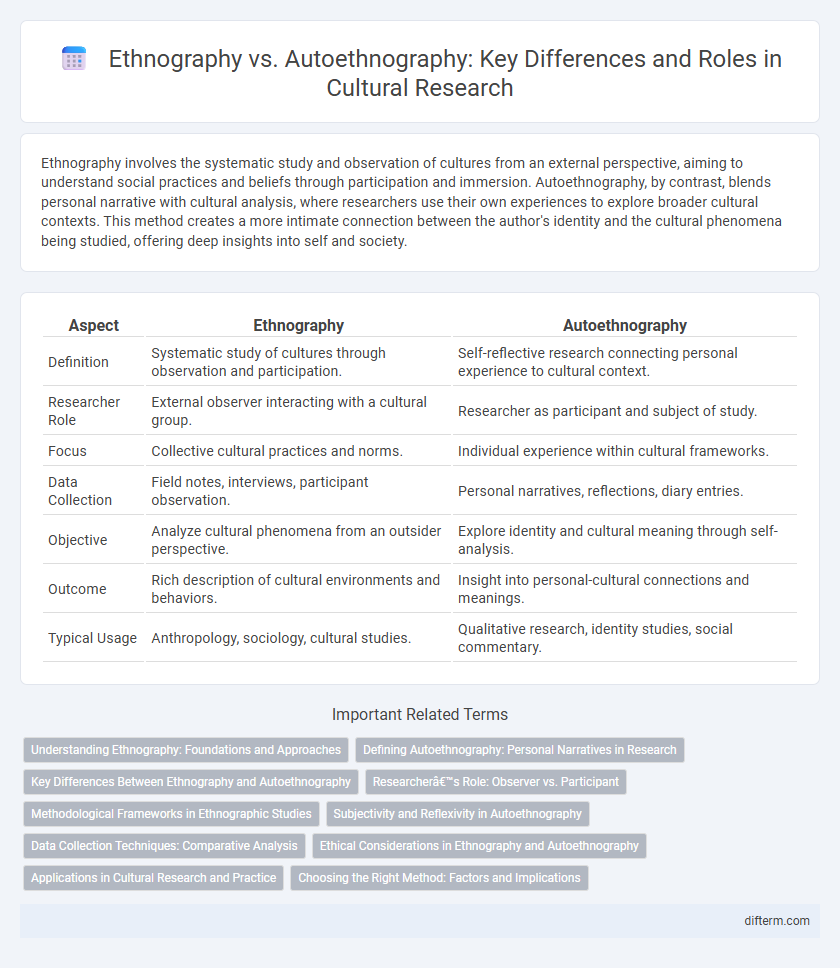Ethnography involves the systematic study and observation of cultures from an external perspective, aiming to understand social practices and beliefs through participation and immersion. Autoethnography, by contrast, blends personal narrative with cultural analysis, where researchers use their own experiences to explore broader cultural contexts. This method creates a more intimate connection between the author's identity and the cultural phenomena being studied, offering deep insights into self and society.
Table of Comparison
| Aspect | Ethnography | Autoethnography |
|---|---|---|
| Definition | Systematic study of cultures through observation and participation. | Self-reflective research connecting personal experience to cultural context. |
| Researcher Role | External observer interacting with a cultural group. | Researcher as participant and subject of study. |
| Focus | Collective cultural practices and norms. | Individual experience within cultural frameworks. |
| Data Collection | Field notes, interviews, participant observation. | Personal narratives, reflections, diary entries. |
| Objective | Analyze cultural phenomena from an outsider perspective. | Explore identity and cultural meaning through self-analysis. |
| Outcome | Rich description of cultural environments and behaviors. | Insight into personal-cultural connections and meanings. |
| Typical Usage | Anthropology, sociology, cultural studies. | Qualitative research, identity studies, social commentary. |
Understanding Ethnography: Foundations and Approaches
Ethnography involves systematic observation and detailed description of cultures through participant observation and fieldwork, prioritizing external perspectives to capture social behaviors and practices. Autoethnography, in contrast, integrates the researcher's personal experiences and reflections to explore cultural phenomena from an insider viewpoint, blending autobiography with ethnographic analysis. Understanding foundational ethnographic approaches requires recognizing their respective emphases on objectivity and subjectivity to reveal nuanced cultural insights.
Defining Autoethnography: Personal Narratives in Research
Autoethnography integrates personal narratives and cultural analysis, emphasizing the researcher's subjective experience within their own community. This method contrasts with traditional ethnography, which observes external cultures, by highlighting introspective storytelling to explore identity, emotion, and social context. Researchers use autoethnography to connect individual experiences with broader cultural phenomena, enhancing emotional engagement and reflexivity in qualitative studies.
Key Differences Between Ethnography and Autoethnography
Ethnography involves immersive fieldwork where researchers observe and analyze cultural practices from an external perspective, emphasizing objective documentation of social behaviors within a community. Autoethnography, by contrast, centers on the researcher's personal experiences as a means to explore cultural phenomena, blending autobiography with ethnographic analysis to provide introspective insights. The key difference lies in ethnography's focus on external observation versus autoethnography's emphasis on self-reflection and subjective interpretation within cultural contexts.
Researcher’s Role: Observer vs. Participant
Ethnography involves the researcher acting primarily as an external observer, systematically studying cultures from an outsider perspective to minimize bias. Autoethnography, in contrast, requires the researcher to participate actively, using their personal experience within the culture to provide deeper, subjective insights. The distinction between observer and participant roles significantly influences data interpretation and narrative style in cultural studies.
Methodological Frameworks in Ethnographic Studies
Ethnography employs a methodological framework centered on immersive observation and interaction within a community to analyze cultural practices from an outsider's perspective. Autoethnography integrates personal reflection and narrative, aligning the researcher's own experiences with broader cultural contexts to provide an insider viewpoint. These frameworks differ in scope and reflexivity, with ethnography emphasizing systematic fieldwork and autoethnography prioritizing subjectivity and self-examination within cultural analysis.
Subjectivity and Reflexivity in Autoethnography
Ethnography emphasizes objective observation of cultural practices, while autoethnography embraces subjectivity by incorporating the researcher's personal experiences and emotions into the analysis. Reflexivity in autoethnography requires continuous self-examination of the researcher's influence on the narrative, highlighting the interconnectedness between self and culture. This methodological approach enriches cultural understanding by blending insider perspectives with academic inquiry.
Data Collection Techniques: Comparative Analysis
Ethnography relies on participant observation, interviews, and field notes to collect data from external cultural groups, emphasizing immersive long-term study. Autoethnography uses self-reflection, personal narratives, and introspective analysis to connect individual experiences with broader cultural contexts. Both methodologies prioritize qualitative data but differ in scope, with ethnography focusing on external observation and autoethnography centering on internal, subjective insights.
Ethical Considerations in Ethnography and Autoethnography
Ethnography requires strict adherence to ethical standards, including informed consent, confidentiality, and culturally sensitive representation of participants to avoid exploitation or harm. Autoethnography, while offering personal insights, demands reflexivity and transparency to critically examine the researcher's positionality and potential biases. Both methodologies emphasize respect for subjects and integrity in data portrayal, highlighting the importance of ethical responsibility in cultural research.
Applications in Cultural Research and Practice
Ethnography in cultural research involves immersive observation and detailed documentation of communities to understand social practices, while autoethnography integrates the researcher's personal narrative to explore cultural experiences from within. Applications of ethnography include analyzing social norms, rituals, and intergroup dynamics in diverse populations, whereas autoethnography offers reflective insights into identity, power relations, and transformative processes. Both methods enhance cultural practice by informing policy development, educational curricula, and community engagement strategies through rich, context-specific data.
Choosing the Right Method: Factors and Implications
Ethnography involves immersive observation and analysis of cultures by an external researcher, while autoethnography centers on the author's personal experience as a cultural lens. Choosing the right method depends on research goals, access to the study population, and the desired depth of cultural insight. Ethnography suits broad cultural understanding, whereas autoethnography provides intimate, reflective perspectives on identity and social context.
ethnography vs autoethnography Infographic

 difterm.com
difterm.com